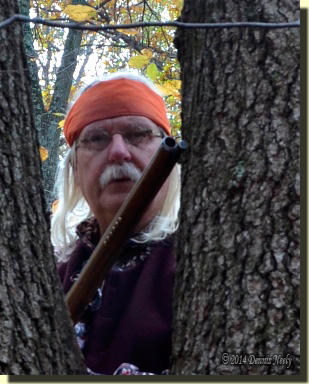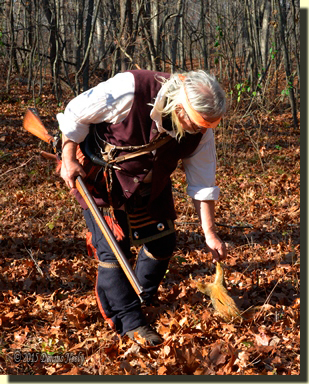Two steps and a pause… Three huge red oak trees with short trunks and broad, spreading limbs stood on the next ridge west. Two steps and a pause… A host of tall, slender oaks, progeny of the three, populated the hill crest. Two steps and a pause… The air smelled warm and dry.
“Caw, caw, caw, caw,” a lone crow, flying in the sideways manner that the black demons sometimes do, winged in the direction of the wooded hillside on the far bank of the River Raisin, deep in the Old Northwest Territory.
Two steps and a pause… The caws faded. “Tseep, Tseep, Tseep,” a tufted titmouse twittered. The little bird with greenish-grey plumage and a feathery top-knot perched on a curved witch hazel branch. Two steps and a pause… The tiny songster canted its head, scrutinizing the hired hunter’s elk moccasins, stained deerskin leggins and faded hunting shirt. “Tseep, Tseep, Tseep,” was its only comment, good or bad.

Two steps and a pause… A fox squirrel bounded from the right matriarch, down the hill and up the rise. A crimson cardinal sang next, “Whit, whit, tsu, tsu, tsu, tsu, tsu.” The cardinal sat on a witch hazel, too, this one ahead, to the right. Two steps and a pause… The fox squirrel nuzzled under old oak leaves. Earth and leaves flew about. Two steps and a pause… Twenty paces to the south, a blue jay swooped from the rustling leaves above.
The pause continued… The blue jay flew on without screaming. Two steps and a pause… “Chukk, chukk, chukk, chukk,” a different fox squirrel barked to the north, but thirty or so paces farther than the first, near the two shag bark hickories on the knoll that rolled into the river’s tangled bottomlands. Two steps and a pause… Another crow passed over, “Caw, caw, caw, caw…”
Two steps and a pause… That morning’s still-hunt, in the Year of our Lord, 1793, continued in the direction of the three old red oak trees. That fox squirrel treed when the crow called. Two steps and a pause… A grey squirrel climbed limb to limb in one of the siblings to the left. Two steps and a pause… The hired hunter’s course ascended the rise, now forty paces distant from the right monarch. Two steps and a pause…
“Barking Off Squirrels…”
A while back, a forum thread challenged the authenticity of measuring a powder charge by pouring powder over a lead ball held in the palm of the shooter’s hand. I posted a passage from John James Audubon’s book, Delineations of American Scenery and Character:
“…He takes from his bag a bullet, pulls with his teeth the wooden stopper from his powder-horn, lays the ball on one hand, and with the other pours the powder upon it until it is just overtopped…” (Audubon, 282).
A week ago, while researching a different passage, I came upon the second mention in Audubon’s missive, this time in the chapter entitled, “Kentucky Sports:”
“…Each man cleans the interior of his tube, which is called wiping it, places a ball in the palm of his hand, pouring as much powder from his horn upon it as will cover it. This quantity is supposed to be sufficient for any distance within a hundred yards…” (Ibid, 60).
Now this chapter covers a variety of marksmanship challenges associated with masters of the American longrifle. But what caught my eye was the subject of the next paragraph. There, in italics, was the topic of another marksmanship feat, “Barking off squirrels.”
As I have shared in recent posts, one of my goals for the upcoming fall hunting season centers on the simple pursuit of small game. I’ve spent a fair amount of time skimming through journal notes looking for small game adventures. To be honest, most involve the hired hunter for Samuel the Trader’s post. Msko-waagosh has a few squirrel and rabbit hunts, as does Mi-ki-naak, but most occurred before either returned white captive came on the scene.
If I recall, Audubon’s recollection of squirrel hunting with Daniel Boone is the primary documentation cited to support the practice of “barking off squirrels.”
“Barking off squirrels is delightful sport, and in my opinion requires a greater degree of accuracy than any other. I first witnessed this manner of procuring squirrels whilst near the town of Frankfort [Kentucky]. The performer was the celebrated Daniel Boon [sic]…
“My companion, a stout, hale, and athletic man, dressed in a homespun hunting shirt, bare-legged and moccasined, carried a long and heavy rifle, which, as he was loading it, he said had proved efficient in all his former undertakings, and which he hoped would not fail on this occasion, as he felt proud to show me his skill. The gun was wiped, the powder measured, the ball patched with six-hundred-thread linen, and the charge sent home with a hickory rod. We moved not a step from the place, for the squirrels were so numerous that it was unnecessary to go after them. Boon pointed to one of these animals which had observed us, and was crouched on a branch about fifty paces distant, and bade me mark well the spot where the ball should hit. He raised his piece gradually, until the bead (that being the name given by the Kentuckians to the sight) of the barrel was brought to a line with the spot which he intended to hit. The whip-like report resounded through the woods and along the hills in repeated echoes. Judge to my surprise when I perceived that the ball had hit the piece of the bark immediately beneath the squirrel, and shivered it into splinters, the concussion produced by which had killed the animal, and sent it whirling through the air, as if it had been blown up by explosion of a powder magazine. Boon kept up his firing, and before many hours had elapsed, we had procured as many squirrels as we wished; for you must know, that to load a rifle requires only a moment, and that if it is wiped once after each shot, it will do duty for hours. Since that first interview with our veteran Boon, I have seen many other individuals perform the same feat.” (Ibid, 60-61).
This passage contains enough quotes for a dozen blog posts on a variety of subjects, and perhaps I can address several in the weeks to come. But with regards to barking off squirrels, a number of thoughts, most focusing on the safety aspects of the practice, flood through my mind.
Boone is using a rifle. I prefer the smoothbore. For most living historians a difference in accuracy exists between the two, depending on skill and mastery. Further, I have a problem hurling a single death sphere, one with a mass of 345 grains and a diameter of .610-inch, at a bushy-tailed squirrel.
As a matter of personal preference, I never shoot on an elevated plane where a miss hurtles a sizeable round ball to points unknown. Stories abound where a house, car or Heaven forbid, a person is hit with a projectile shot in the air that missed its intended mark.
Plus a direct hit with that round ball transforms a meager meal into a pitiful hors d’oeuvre. Lead shot is another matter, but even then the death bees inflict damage to valuable meat. In essence, I don’t take shots in trees with round balls. That practice is not safe in today’s world.
That said, early on in my journey back in time, I tried barking squirrels with the .40-caliber Dickert flintlock rifle. Those were careful shots, downhill at squirrels in low branches or on deadfalls where the miss ended up in either the nasty thicket or the big swamp. That is one blessing of rolling southern Michigan hills.
I’ve never tried with “Old Turkey Feathers” and have no intention of attempting that feat. That is not to say that I don’t get a real kick out of shooting at the “Bark the Squirrel” paper target that shows up from time to time at black powder shindigs.

Over four decades, I’ve heard a fair number of tales from other traditional woodsmen who have tried barking off squirrels. A dancing fire, a twinge of guilt/honesty and a few good companions make for a lot of “you-won’t-believe-what-I-did” laughs. I find it interesting that most, but not all, of those stories end in the same way—by the spinner of the yarn almost getting bit by an angry squirrel. Now and again, a hard hit that splinters the wood with explosive force does the trick, consistent with Audubon’s observation. The “explosion of a powder magazine,” is the key phrase.
That said, I cannot count on two hands the number of times I’ve seen a twig break from under a grey or fox squirrel. Sometimes the critters get lucky, grasp a branch on the way down, dangle and struggle, then right themselves—and sometimes they don’t. I’ve never seen a fall from a tall oak or hickory kill a squirrel. A few were stunned and acted dead, but that didn’t last.
In the majority of recollections, the bark peeled, maybe splintered some, the squirrel fell, the linen and leather clad marksman patted himself on the back (I’ve never heard of a lady trying to bark off a squirrel—“we’re smart enough not to try,” Miss Tami once said with a wink), and reached for that bushy tail—without poking the little beastie or watching to see if it was still breathing. As I’ve often said, Congress should pass a law that every squirrel in the forest must have a sign with bold red letters affixed to its bushy tail that reads: “Grab at your own peril!”
Still, I’m getting impatient waiting for a chance to see what the squirrel woods offers…
Give traditional black powder hunting a try, be safe and may God bless you.



One Response to What the Squirrel Woods Offers…